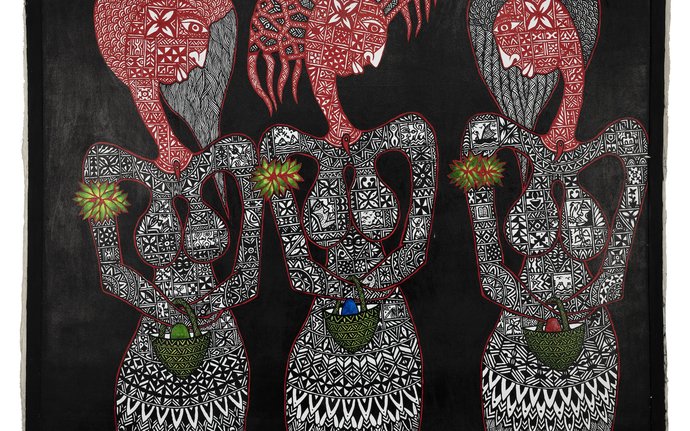Emele Ugavule's bold vision for New Zealand's Pacific arts community
26 Jun 2024, Tyson Beckett
This article first appeared in Stuff in 'Your Weekend' magazine, 22 June, 2024

This article first appeared in Stuff in 'Your Weekend' magazine, 22 June, 2024

Takapuna-born, Australian-raised arts practitioner Emele Ugavule hosts Tok Talanoa, a symposium held at Pātaka Art + Museum in Porirua that encourages participants to gather, talk and eat as they explore the rich and diverse creative artisans of Melanesia.
Sitting alongside the event are three exhibitions that open concurrently: The Ulumate Project; Red Wave, Blue Wave and Sanup Wantaim.
All are an opportunity for the wider community to connect, share knowledge and stories. Ugavule knows the value of this personally. In 2023, the founder of Indigenous-led arts collective Studio Kiin relocated from Perth to Wellington to take up a position as senior acting lecturer at Toi Whakaari: NZ Drama School, seeking, she says “to expand my skills and also be in a place where Indigenous storytelling was really valued in the institution”.
Tyson Beckett caught up with the Tokelauan Fijian storyteller to hear about her impressions of, and visions for Aotearoa’s Pacific arts community.

It definitely helped that I have already had connections having worked here in visual arts, those were predominantly through the Fijian community. The community that I found here in Aotearoa is very different to my experience in Australia. This is the largest community of Tokelauans that I’ve ever lived in. I have really been amazed and enjoyed being around a lot of the Tokelau community, seeing the way that storytelling exists here and then the amount of initiatives that are here to support Pacific artists.
In Australia, I feel like my artist’s identity has always been informed by me being a Pacific person and the stories that I want to tell, but I was always kind of competing with everybody else. Whereas here in Aotearoa, there are initiatives and pathways for Pacific artists. It’s been really amazing to be able to be in spaces that are designed by Pacific people that have us in mind and our values in mind.
But I look forward to being in more spaces where there is more diversity in the Pacific people that are in those spaces. More Micronesian community and more Melanesian community and spaces that are inclusive of our Francophone cousins in the Pacific as well.
For me the key themes are trying to create intergenerational spaces, that young people can be in and elders can be in and people at different points of their careers - some of our speakers are emerging, some wouldn't even consider themselves artists, but I would.
There's multiple ways that people can engage with it - workshops, keynotes, panels and then food. I know sometimes these things can be overwhelming when it's just people talking, talking, talking. We are multi-textured and multi-layered in the way that we share stories, the way that we talk and also the way that we listen as Melanesian people. I wanted the programming to reflect that.
The event is supported by Creative New Zealand's Pacific Arts Strategy, part of which is to help support bold and enterprising Pacific arts that make a difference to the world around them.

I'm just trying to be myself and I'm trying to create spaces where other people can be their full selves as well.
It's about using opportunities like this to create time and space for people to show up as themselves and to be unapologetic about that. And to really embrace the fact that we as Melanesian people are really rich and generous in the way that we relate to others, the way that we see the world and the way that we express ourselves.
My biggest hope is that from this, people will walk away feeling proud of who they are.
From my experience we risk a real monolithic culture and world view.
When it comes to things like problem-solving, invention and ingenuity, that kind of monolithic world view and language to approach these things is really unhelpful and creates challenges and barriers. Just being here in Aotearoa and seeing what tangata whenua offer, there's so much for me to learn from and to help me see and understand about my own culture.
Melanesia has the largest indigenous population in the Pacific and also the greatest diversity of languages in the Pacific region.
There is so much diversity in just the way that through languages people are able to see the world, describe the world and understand the world.
The risk of not being able to see the beauty of that... the cost is our health and our wellbeing.
Mataliki is definitely an important part of our traditional Tokelauan lunar calendar. For me personally, I didn't grow up with that knowledge
- I had to learn about it through my own interest, learning more about my great grandfather, who was a master fisherman. There was a story one of my great aunties told me about how he was able to read the position of the moon and where the waves were to inform her labour, telling her when she was going to go into labour and give birth. That started for me my curiosity around the Mahina Hoka Tokelau.
Fiji has an equivalent of that, which is Vula Vakaviti. They both start in the middle of the year - I've come to both later in my life, but through the stories of the fishermen in my family and my husband who is also a traditional fisherman and learning the knowledge that he knows, also encouraged me to think about that in everything that I do and how we embody those knowledges, even as diaspora.